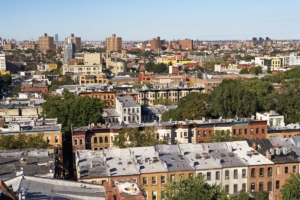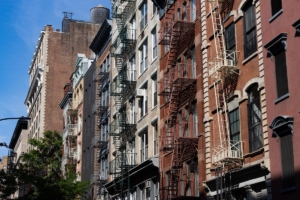The busy home-shopping season is rapidly approaching, and prospective buyers may wonder whether a hotter market is really a good thing. When is the best time to buy an apartment in NYC? Do buyers really get better deals during the peak season, or simply more choices?
Actually, both. While we find that the best time to rent is ambiguous — the rentals market offers the best options in the summer but the best deals in the winter — our analysis shows that the for-sale market is different. Peak home buying season occurs twice throughout the year, once in the spring and once in the fall, when buyers will find more choices, hotter inventory, more discounts, and lower prices.
Of course, the “best” time to buy is a personal decision that depends on many factors beyond market conditions. If you find the right place during the off season, go for it — keeping in mind that you’ll face a different home shopping landscape at different times.
Buyers Have the Most Choices in Spring and the Fewest in Winter
Peak home-buying season is marked by the highest levels of inventory and demand. While buyers face more competition from each other during peak season, high inventory levels mean plenty of options. These trends are most prominent in the spring, and occur again, to a lesser extent, in the fall. Buyers will see the most selection from April through June, when sellers rush to put their homes on the market, knowing that this, in turn, is when demand peaks. Inventory levels rise again in October, after summer vacation and the back-to-school rush. Inventory levels are lowest in the winter months, from December to February. These variations mean that prospective buyers looking in May have access to almost 2,000 more units than those looking in December, relative to an average of 15,000 units per month in 2017.
Price Cuts Are Most Frequent in the Spring and Fall
Buyers will not only have more inventory to choose from during peak home-buying season — they will also find more discounts. Homes are 10 to 20 percent more likely to receive price cuts between April and June. The likelihood of price cuts dips in the summer and peaks during the second flurry of home-buying in September and October, as owners rush to sell after the summer but before the holidays. Price cuts are 20 percent less likely in August and 20 percent more likely in September and October. Buyers are least likely to find discounts during the holiday season. In December, when inventory levels are also lowest, price cuts are 40 percent less frequent.
The pattern of discounts relative to inventory levels is different in the sales market than the rentals market. With rentals, price cuts are more likely when inventory levels are lower, suggesting that discounts are used to move stale inventory off the market. In the sales market, however, discounts are more common during the busier season, suggesting that there may be a surplus of homes and that sellers could be using discounts to attract buyers’ attention.
Homes Move Quickly During Peak Season
The amount of time homes stay on the market also varies between seasons. In 2017, homes in New York City stayed on the market for an average of 70 days. During the spring, when inventory levels and discounts are high, the median number of days on market is more than 20 percent lower than the average. Thus, homes stay on the market for 10 to 15 fewer days between April and June compared to the rest of the year.
Homes also come off the market a week quicker in October, during the return of home-buying season. This suggests that the inventory at these times consists of hot units that shoppers rush to buy. Though the market is more competitive during the peak season, inventory levels are high enough for buyers to have plenty of options. The fact that inventory during the slower seasons takes longer to sell could be due to a lack of demand or a higher proportion of less-desirable units.
Prices Are Stable Across Seasons But Lowest in Spring
Similar to the rentals market, the biggest driver of price changes is time, rather than seasons. The StreetEasy Price Index, which controls for unit quality over time, has grown by 5 percent over 2017, but fluctuates by no more than 1 percent throughout the year due to seasonality. Prices are highest in July through September, and lowest in the winter and spring. The StreetEasy Price Index changes by no more than $4,500 between March and August, the cheapest and most expensive months, respectively. Buyers can expect to pay between 0.3 and 0.4 percent less if they buy in the spring. This means saving up to $2,000 on a $500,000 apartment, or up to $12,000 on a $3,000,000 unit. These amounts may make a difference to some buyers, but prices generally do not fluctuate enough across seasons to justify selling or buying in a particular month. Home buyers should take other factors — such as higher discounts and more inventory in the spring and fall — into consideration.
Spring and Fall Are the Best Time to Buy
The busy time for home buyers occurs in spring and fall for good reason. Both seasons see higher levels of inventory, more frequent discounts, lower prices, and hotter units that come off the market quickly. Prospective buyers shopping during the busy seasons are likely to find better deals, higher-quality inventory, and more choices despite the greater competition. Spring shoppers have access to the biggest selection, which increases the likelihood of finding an ideal home, but fall shoppers are more likely to find discounts.
New York City has a different home-buying landscape than other cities. Nationally, the best time to buy is late summer, when buyers can find more inventory and discounts; homes sell for a premium during the spring. In New York City, the housing market cools during the late summer months as New Yorkers leave to go on vacation, and it cools again during the winter holidays. City dwellers looking to buy and sell their homes can rest assured that the peak home buying seasons do not need to impact their vacation plans.
Ultimately, the best time to buy is a highly personal decision, and buyers are encouraged to look for homes at any time that is right for them. However, those who can choose may have a higher likelihood of finding a good deal on their dream home in the spring and the fall, when the housing market offers the most choices and the steepest discounts.
How We Did It
We used a weighted moving average method on StreetEasy’s NYC Price Index, sales inventory, price cuts, and median days on market, in order to smooth these measures over time and adjust for seasonality. Taking the difference between our observed values and the smoothed values for each month, we then calculated the monthly average of these differences from 2010 to 2016.
—
Hey, why not like StreetEasy on Facebook and follow @streeteasy on Instagram?










